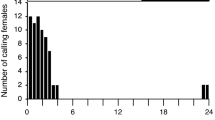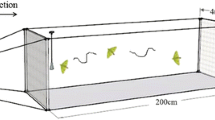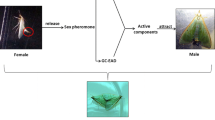Abstract
Behavioral patterns and pheromone titer in females of the steam borer Diatraea indigenella Dyar & Heinrich were assessed for 7 days during scotophase under a 13:11 L:D photoperiod. Calling was observed from the first scotophase for most of the females. The highest percentage of calling females was recorded 6 h after the onset of scotophase. Calling bouts and length of calling were affected by age, decreasing dramatically after the sixth scotophase. By coupling chemical and electrophysiological techniques (GC–EAD, GC–MS) and olfactometer bioassays (Z,E)-9,11-hexadecadienal was identified as the main sex pheromonal component in the extracts of female glands. The concentration varied from 2.53 to 13.7 ng gland−1 with a peak at the 6th hour of scotophase. In addition, two unidentified secondary active components were detected at very low concentrations. Behavioral assays showed that 86% of the male moths were more attracted to the gland extracts than to hexane (control), and 77% of the male moths were more attracted to the gland extract than to the synthetic major component (Z,E)-9,11-hexadecadienal. However, 68% of males preferred the synthetic major component over hexane. The identification of the major sex pheromonal component represents an important step toward the complete elucidation of the composition of the sex pheromone of D. indigenella in order to develop monitoring tools.



Similar content being viewed by others
References
Ayres M, Ayres M Jr, Ayres D, Santos A (2003) Bioestat 3.0 Aplicações estatísticas nas áreas das ciências biológicas e médicas. Sociedade Civil Mamirauá, Belém, 291 p
Babilis NA, Mazomenos BE (1992) Pheromone production in Sesamia nonagrioides: Diel periodicity and effect of age and mating. J Insect Physiol 38:561–564
Batista-Pereira LG, Santangelo EM, Stein K, Unelius CR, Eiras AE, Correa AG (2002) Electrophysiological studies and identification of possible sex pheromone components of Brazilian populations of the sugarcane borer, Diatraea saccharalis. Z Nat C Biosci 57:753–758
Batista-Pereira LG, Wilken CF, Neto SDP, Marques E (2004) Comportamento de Chamamento de Thyrinteina arnobia (Stoll) (Lepidoptera: Geometridae) em Psidium guajava, Eucalyptus grandis e em Dieta Artificial. Neotrop Entomol 33:021–028
Berger RS (1972) 2,6-Dichlorophenol, sex pheromone of the lone star tick. Sci 177:704–705
Box HE (1930) The crambinae Genera Diatraea and Xanthopherme (Lep., Pyral.). Bull Entomol Res 22:27–28
Cabrera A, Eiras AE, Gries G, Gries R, Urdaneta N, Mirás B, Badji C, Jaffe K (2001) Sex pheromone of tomato fruit borer, Neoleucinodes elegantalis. J Chem Ecol 27:2097–2107
Cardé RT, Haynes KF (2004) Structure of the pheromone communication channel in moths. In: Cardé RT, Millar JG (eds) Advances in insect chemical ecology. Cambridge University Press, Cambridge, pp 283–332
Cardé RT, Roelofs WL (1973) Temperature modification of the male sex pheromone response and factors affecting female calling in Holomelina immaculata (Lepidoptera: Arctiidae). Can Entomol 105:1505–1512
Da Silva EL, De Carvalho CM, Do Nascimento RR, Mendonça AL, Da Silva CE, Gonçalves GB, De Freitas MDRT, Sant’Ana AEG (2006) Reproductive behaviour of the Annona fruit borer, Cerconota anonella. Ethol 112:971–976
Del Mazo-Cancino A, Malo EA, Cruz-López L, Rojas JC (2004) Diel periodicity and influence of age and mating on female sex pheromone titre in Estigmene acrea (Lep., Arctiidae). J Appl Entomol 128:459–463
Delisle J, Royer L (2004) Changes in pheromone titer of oblique-banded leafroller, Choristoneura rosaceana, virgin females as a function of time of day, age; temperature. J Chem Ecol 20:45–46
Gadenne C (1993) Effects of fenoxycarb, juvenile hormone mimetic, on female sexual behaviour of the black cutworm, Agrotis ipsilon (Lepidoptera: Noctuidae). J Insect Physiol 39:25–29
Goméz LA, Lastra LA (1995) Los barrenadores de la caña de azúcar. Serie Divulgativa, Cenicaña, 6
Gómez VRC, Rojas JC (2006) Calling behavior of Zamagiria dixolophella (Lepidoptera:Pyralidae). Fla Entomol 89:83–84
Hammond AM, Hensley SD (1971) The sugarcane borer sex attractant. Entomophaga 16:159–164
Hou ML, Sheng CF (2000) Calling behaviour of adult female Helicoverpa armigera (Hübner) (Lep., Noctuidae) of overwintering generation and effects of mating. J Appl Entomol 124:71–75
Kalinová B, Kindl J, Hovorka O, Hoskovec M, Svato A (2005) (11Z)-hexadec-11-enal enhances the attractiveness of Diatraea saccharalis main pheromone component in wind tunnel experiments. J Appl Entomol 129:70–74
Kawazu K, Honda H, Nakamura S, Adati T (2007) Identification of sex pheromone components of the box tree Pyralid, Glyphodes perspectalis. J Chem Ecol 33:1978–1985
Kawazu K, Adati T, Tatsuki S (2011) The effect of photoregime on the calling behavior of the rice leaf folder moth, Cnaphalocrocis medinalis (Lepidoptera: Crambidae). JRQ-Jpn Agr Res Q 45:197–202
Kinjo K, Arakaki N (1997) Mating behavior of the cotton caterpillar, Diaphania indica (Saunders) (Lepidoptera: Pyralidae). Appl Entomol Zool 32:641–644
Konno Y, Honda H, Matsumoto Y (1980) Observation on the mating behavior and bioassay for the sex pheromone of the yellow peach moth, Dichocrocis punctiferalis Guenée (Lepidoptera: Pyralidae). Appl Entomol Zool 15:321–327
Leslie G (2007) Pest of sugarcane. In: Glyn J (ed) Sugarcane (World Agriculture Series). Blackwell Publishing Company, Ames, pp 78–96
Palacio Cortés AM, Zarbin PHG, Takiya DM, Bento JMS, Guidolin AS, Consoli FL (2010) Geographic variation of sex pheromone and mitochondrial DNA in Diatraea saccharalis (Fab., 1794) (Lepidoptera: Crambidae). J Insect Physiol 56:1624–1630
Perez R, Hensley SD (1973) A comparison of pheromone and black-light traps for attracting sugarcane borer Diatraea saccharalis F. Adults from a natural population. J Agric Univ P R 57:320–329
Svatoš A, Kalinová B, Kindl J, Kuldova J, Hovorka O, Do Nascimento RR, Oldham NJ (2001) Chemical characterization and synthesis of the major component of the sex pheromone of the sugarcane borer Diatraea saccharalis. Collect Czechoslov Chem Commun 66:1682–1690
Tillman JA, Seybold SJ, Jurenka RA, Blomquist GJ (1999) Insect pheromones—an overview of biosynthesis and endocrine regulation. Insect Biochem Mol Biol 29:481–514
Trematerra P (2012) Advances in the use of pheromones for stored-product protection. J Pest Sci 85:285–299
Turgeon J, McNeil J (1982) Calling behaviour of the armyworm, Pseudaletia unipuncta. Entomol Exp Appl 31:402–408
Vargas GA, Goméz LA (2005) Evaluación del daño causado por Diatraea spp. En caña de azúcar y su manejo en el valle del río Cauca. Serie Divulgativa, Cenicaña, 9
Webster RP, Cardé RT (1982) Relationships among pheromone titre, calling and age in the omnivorous leafroller moth (Platynota stultana). J Insect Physiol 28:925–933
William JR, Metalcafe JR, Mungomery RW, Mathes R (1969) Pests of sugar cane. Elseiver Publishing Company, Amsterdam, 393 p
Witzgall P, Kirsch P, Cork A (2010) Sex pheromones and their impact on pest management. J Chem Ecol 36:80–100
Yang CY, Jung JK, Han KS, Boo KS, Yiem MS (2002) Sex pheromone composition and monitoring of the oriental fruit moth, Grapholita molesta (Lepidoptera: Tortricidae) in Naju pear orchards. J Asia Pac Entomol 5:201–207
Yang CY, Lee S, Choi KS, Jeon HY, Boo KS (2007) Sex pheromone production and response in Korean populations of the diamondback moth, Plutella xylostella. Entomol Exp Appl 124:293–298
Yu-yong X, Mao-fa Y, Zi-zhong L (2009) Sex pheromone components of the female black cutworm moth in China: identification and field trials. Zool Res 30:59–64
Zarbin PHG, Lorini LM, Ambrogi BG, Vidal DM, Lima ER (2007) Sex pheromone of Lonomia obliqua: daily rhythm of production, identification, and synthesis. J Chem Ecol 33:555–565
Acknowledgments
The authors would like to thank Dr. Délia Pinto-Zevallos for comments and improvement of the language. Cnpq, Capes, Fundação Araucária, and Instituto Nacional de Ciência e Tecnologia (INCT) Semioquímicos na Agricultura are acknowledged for their financial support.
Author information
Authors and Affiliations
Corresponding author
Additional information
Edited by Stefano Colazza – Univ of Palermo
Rights and permissions
About this article
Cite this article
Palacio-Cortés, A.M., Fonseca, M.G. & Zarbin, P.H.G. Toward the Identification of the Sex Pheromone of Diatraea indigenella Dyar & Heinrich (Lepidoptera: Crambidae): Calling Behavior and Chemical Structure of a Major Component. Neotrop Entomol 43, 526–531 (2014). https://doi.org/10.1007/s13744-014-0246-5
Received:
Accepted:
Published:
Issue Date:
DOI: https://doi.org/10.1007/s13744-014-0246-5




